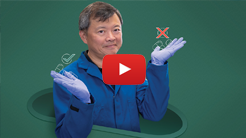UCI Professor Abe Lee’s Journey to Lab-on-a-Chip
The accomplished researcher and entrepreneur helps establish a UCI department, startup ventures and pivotal research.
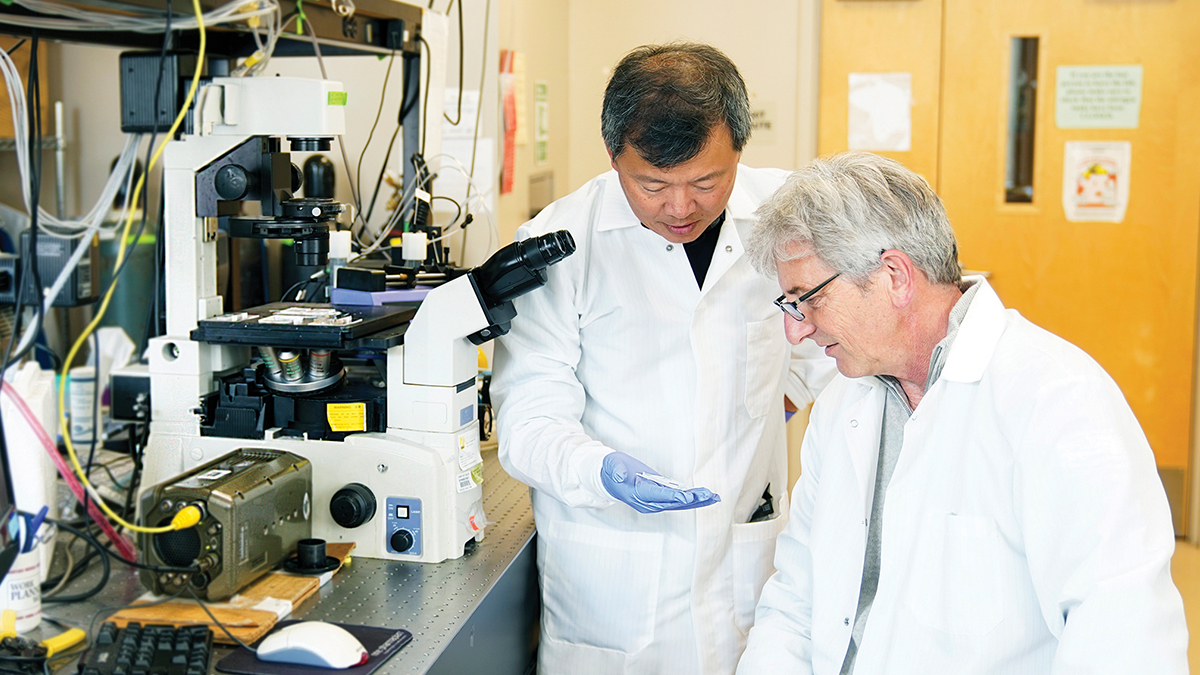
UCI professors Abe Lee and Chris Hughes working together in the Center for Advanced Design and Manufacturing of Integrated Microfluidics (CADMIM) at UCI’s Henry Samueli School of Engineering. Jackie Connor / UCI Beall Applied Innovation
July 16, 2019 - Abe Lee is no stranger to pursuing ambitious research and reaching goals. The distinguished professor has over 40 issued patents – several of which have been licensed to major corporations – and he is a William J. Link Professor, the Director of the Center for Advanced Design and Manufacturing of Integrated Microfluidics and chair of UCI’s biomedical engineering department.
Following an illustrious career path and arriving at UCI in 2001, Lee’s decades of collaboration to solve the problems linked to neurodegenerative diseases and pharmaceutical efficacy all stems back to microfluidics and his early ability of combining engineering and biological systems. Through collaborations on and off campus, Lee helped grow everything big and small at UCI, from the biomedical engineering program, to several startup ventures, to developing tiny organs to help progress drug development and precision medicine.
Rewind: Before UCI
Originally trained as a mechanical engineer with his Ph.D. focusing on microelectromechanical systems, from 1992 until 1999, Lee worked at Lawrence Livermore National Lab (LLNL) where he worked on the stroke initiative and developed clinical tools to treat stroke.
“There was a lot of emphasis on heart diseases and cancer, but stroke was probably the number one in terms of cost, because of the effect of stroke resulting in people losing work or losing jobs and being bed ridden or even comatose.”
This led him toward a field that, at the time, was brand new to the science scene: biomedical engineering.
“It was an exciting time for national labs in general to spin off technology to the commercial or private sectors,” said Lee. “It was a new era. It changed a little afterward, but it still started the trend.”
After LLNL, Lee spent three years working at the Defense Advanced Research Projects Agency (DARPA) where he worked as a program manager in the Micro Technology Office. He established a program coined “Biofluidic Chips or BioFlips,” with the goal of developing a “physiological status monitoring” system for troops that monitored their wellbeing and combat preparedness. Eventually, he worked with generals to develop this tech as a form of national security and defense.
In addition, while at DARPA, Lee utilized his experience to develop the $60 million BioFlips program, which would incorporate the same principles and technologies behind mechanical engineering into living systems.
“I realized you need to deal with fluids in the devices we developed because the body is primarily water and I also realized it’s not just the doctors that need to get down to the biology,” said Lee.
Then, around the time of the Human Genome Project completion, an international scientific research project that mapped all of the human genome, Lee also began to think about diagnostics and treatment in conjunction with the human genome project.
“We were starting to get to the core of what are the few molecules or a few cells or a few bad pathogens that are triggering this whole thing,” said Lee. “So, going back to the root cause – people refer it today as precision medicine. That was kind of the stage of where I think a lot of these technologies were starting to form.”
After a short stint at the National Cancer Institute, Lee learned more about the biology of cancer and although he was originally planning to go back to LLNL, he decided to come to UCI in 2001.
“That experience made me feel that I really want to be the one involved in the projects, instead of managing a portfolio of projects,” said Lee. “So, I applied for a faculty position at UCI.”
Collaborate with Thy Neighbor
After moving to Irvine, several children’s playdates and conversations led Lee to discover a potential collaboration with fellow faculty and neighbor, Lisa Flanagan, Ph.D., associate professor of neurology at UCI Health. From his previous profession, Lee brought a microfluidic pump he developed at LLNL, and after much discussion with Flanagan, the two discovered the technology was applicable to her research, which required ways to enrich and sort neural stem cells for treating neurodegenerative diseases.
“My microfluidic pumps and devices can start to separate cells that are of your target interest with molecular basis. I thought maybe we can give it a try,” said Lee.
By separating the cells, Lee and Flanagan were able to better identify stem cells by their individual electrical signatures, and Flanagan is continuing this research toward the ultimate goal of treating neurodegenerative diseases such as Alzheimer’s and Parkinson’s. The coincidental collaboration fostered 10 years of research, publications and patents.
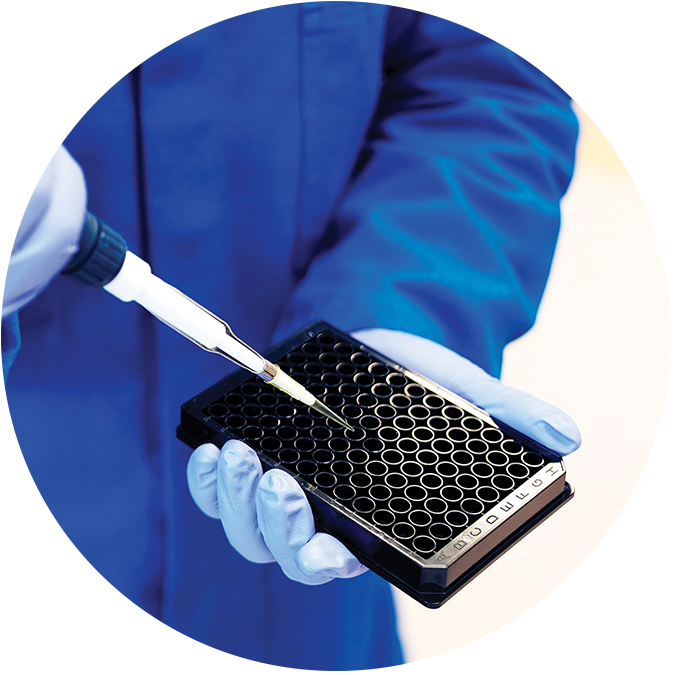
A microfluidic chip that holds a multi-unit array, and is used as a platform for large-scale drug screening. Jackie Connor / UCI Beall Applied Innovation
Introducing Anteaters to Biomedical Engineering
Alongside Lee’s collaboration, the biomedical engineering center expanded into a department at UCI in 2002. Lee, in addition to a few other faculty members, helped grow the small-but-mighty curriculum, which later became one of UCI’s most popular majors.
“There was a lot of interest and excitement because this area [Irvine] is home to a large number of biomedical device companies,” said Lee. “There’s a need for a strong biomedical engineering program here to build out an ecosystem of innovative research and to educate and train future employees.”
Microfluidics, in particular, took hold and has since branched out into multiple research endeavors and collaborative organizations on campus, including the Center for Advanced Design and Manufacturing of Integrated Microfluidics (CADMIM), which moves microfluidics and other technologies from the university laboratories toward industry and commercial applications.
“The projects are defined by companies and they tell us the general need in the industry,” said Lee, CADMIM director. “We explore solutions to the problems defined by the companies and, based on their requirements, we respond with research concepts and projects.”
Previously, the CADMIM team and UCI have collaborated to build an agricultural microfluidics system for Corteva Agriscience, a subsidiary of the Dow Chemical Company that specializes in agricultural chemicals and biotech solutions.
Presently: Aracari
A little over two years ago, Lee, Steve George, M.D., Ph.D., director of UCI Edwards Lifesciences Center for Advanced Cardiovascular Technology and Chris Hughes, professor and chair of molecular biology and biochemistry, co-founded Kino Biosciences, now known as Aracari, a startup company based on developing tools that sharpen and revolutionize drug discovery and development with a long-term goal of creating personalized medicine platforms and databases.
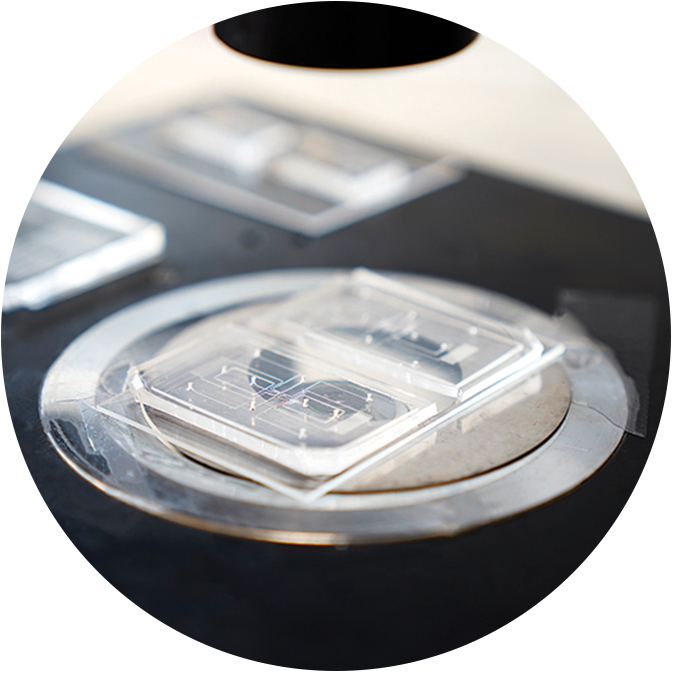
Lee’s organ-on-a-chip under the microscope. These tiny organs aim to help develop medicine best suited for the patient. Jackie Connor / UCI Beall Applied Innovation
The palm-sized technology, often referred to as a “lab-on-a-chip,” incorporates a proprietary vascularized micro organ (VMO) device that recreates complex 3D cellular structures where oxygen and nutrients are transported through formed blood vessels. The cells that build the VMOs are currently harvested from cord blood, but efforts are in place to harvest using a patient’s stem cells with the end goal of personalized medicine.
“I think it’s pretty exciting because we are establishing a very good track record of working with top pharma companies in the world,” said Lee.
So far, the company’s device can recreate 16 VMOs with each VMO taking several days to grow. They have also successfully recreated micro organs such as heart, liver, pancreas and brain to help speed up drug discovery and save money on personalized medicine.
The startup also developed vascularized micro tumors (VMT), which are used to recreate tumor cell types. With VMTs, a pharmaceutical company would be able to test the toxicity of a drug and a drug’s interactions with healthy tissues and other body parts.
“This will be a platform where pharma can quickly say ‘I can check mark this off, check mark that off, toxicity, efficacy and other types of side effects,” said Lee.
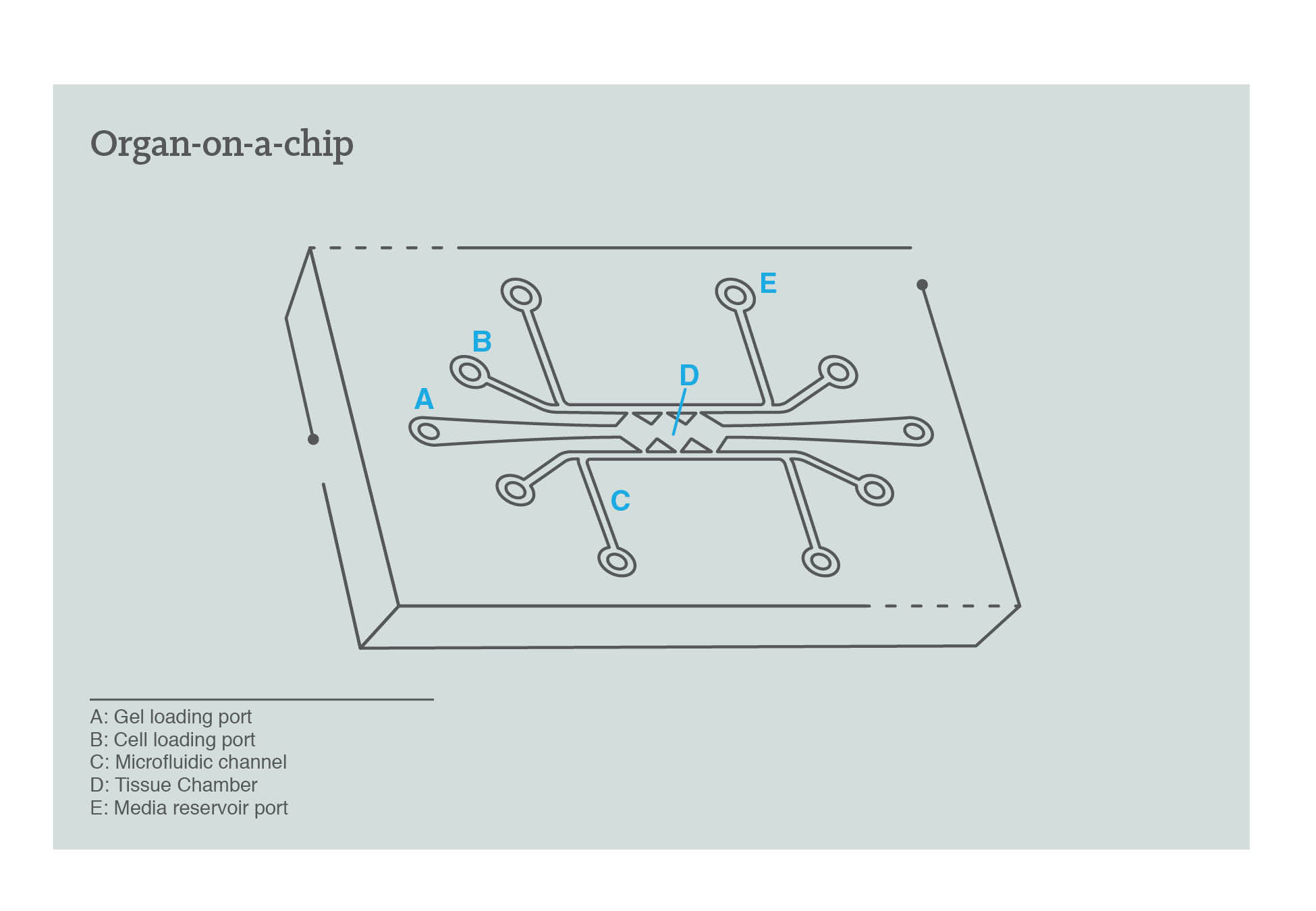
Organ-on-a-chip
Lee recently received a Proof-of-Product grant for Aracari through UCI Beall Applied Innovation in addition to a $250,000 Small Business Innovation Research grant. Additionally, his former students have also formed startup companies, such as BioPico, a startup that developed a closed automated system for therapeutic stem cell cultures.
“When I started the company in 2011, I shared my idea for field potential based flow cytometry,” said John Collins, Ph.D., CEO of BioPico. “Abe was the first one to endorse the idea, which resulted in some funding. He was even willing to rent his lab to do initial feasibility studies.”
Fast Forward: Future
Looking ahead with Aracari, Lee and team will continue to develop their platform as well as develop a clientele base that includes top pharma companies.
“Our platform is unique and powerful compared to the competition, so we’re trying to promote and market this to the pharma companies so they realize what we can do for them,” said Lee. “They start to see this as a powerful way to predict if their drugs are good or bad.”
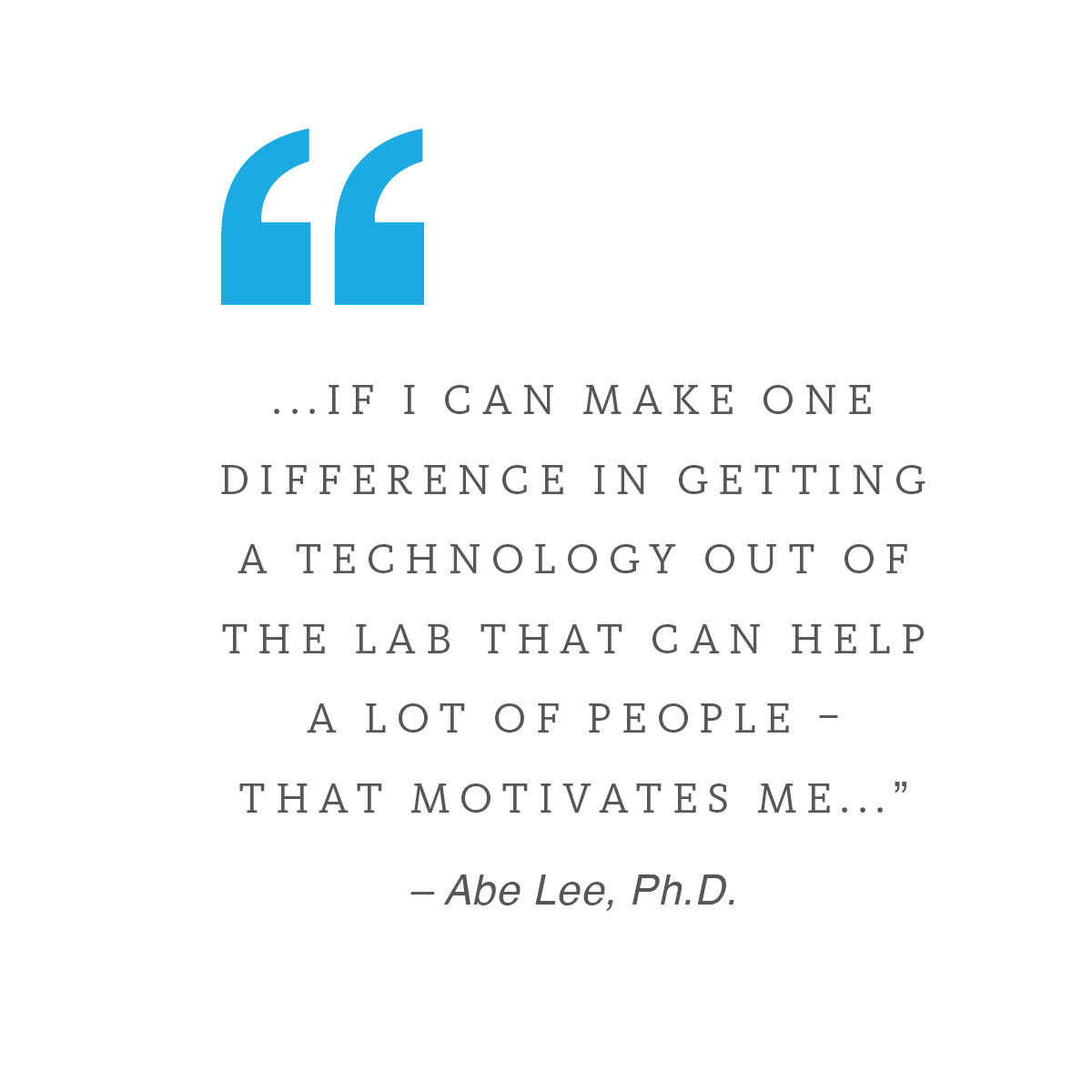
Additionally, Lee hopes to gain more capital to increase the staff size within the company so the team can start to develop other platforms that are more focused on personalized medicine. He plans to work with hospitals to help doctors decide the best drug for their patient.
“I continue to enjoy fundamental research and publishing our results to push the forefront of technology,” said Lee. “Now, I feel like I don’t have to publish for the sake of publishing … rather, if I can make one difference in getting a technology out of the lab that can help a lot of people – that motivates me all the more.”
- Jackie Connor / UCI Beall Applied Innovation

